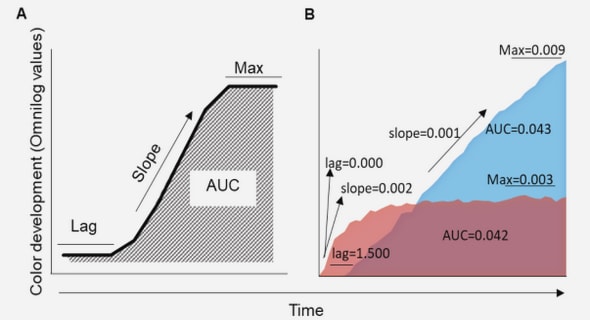Get Complete Project Material File(s) Now! »
Astronomic theory of climate change
The relative position and orientation of the Earth during its yearly elliptical journey around the Sun determines how much solar radiation is received at different latitudes during a year. The received radiation is controlled by three orbital parameters described in Fig. 2.3: the obliquity or tilt of the Earth polar axis relative to the elliptic plane, the precession of equinox that corresponds to the season when the Earth is closest to the Sun on the ellipse (perihelion), and the eccentricity that describes the degree of elongation of the ellipse. Tilt causes seasons because the hemisphere pointing toward the Sun receives more radiation. Change in tilt between 22 and 25 occurs with a 41 kyr (thousand years) periodicity and controls the intensity of seasonality: the larger the tilt, the larger the insolation contrast between the two hemispheres. Today the Earth reaches the perihelion in January, causing slightly milder winters in the Northern Hemisphere, as opposed to 11 kyr ago when perihelion was approached in July (19 kyr and 23 kyr periodicity). Eccentricity varies in 100 kyr and 400 kyr cycles and controls how the timing of perihelion combines with seasonality (tilt); thus, the relative severity of summer and winter time in each Hemisphere.
Milankovitch (1930) calculated the past position and inclination of the Earth and associated the changes in seasonality with the glacial–interglacial cycles that have characterized the Earth’s climate for the past 2 Myr. Ice ages, cold temperatures and large ice volume, correlate well with the 65 N summer insolation (Emiliani, 1955; Berger, 1978), as shown on the Vostok record Fig. 2.2; thus, small changes in insolation get amplified by feedbacks in the climate system that lead to a global cooling of 5 C and the inception and growth of large ice sheets that drew down sea level by 120– 135 m (e.g., Yokoyama et al., 2000). If insolation is indeed the “pacemaker of ice ages” (Hays et al., 1976), future glaciations can be predicted and the next one should not happen before at least 50 kyr (Berger and Loutre, 2002). However, the astronomical theory of climate does not tell how warm the climate is going to be nor how high sea level will rise over the next decades and centuries; thus, I will especially focus on the climate and behaviour of ice sheets during former periods that most resembled modern conditions and try to improve the understanding of glacial archives by predicting the conditions under which they were generated and preserved.
Ice sheets and fast climate change
Though the Milankovitch theory may well explain the inception and expansion of large ice sheets, isotopic and geomorphologic records display a high frequency variability during glacial periods that is not present in the insolation signal. For instance, deep-sea sediment records in the North Atlantic (Fig. 2.4) contain a series of layers that are rich in sediments also found in eastern Canada and poor in foraminifera, thus reflecting cold sea-surface temperature. These records suggest that intense and short-lived release of large armadas of icebergs released from the Laurentide Ice Sheet exported enough freshwater to shut down the thermohaline circulation of the ocean, effectively cooling down the climate in the North Atlantic region by 5 C. These Heinrich Events (Heinrich, 1988; Bond et al., 1992) are believed to result from surges or oscillations in the ice stream regime of the Laurentide Ice Sheet and have motivated the development of the UBC Ice Sheet Model used for my studies of Greenland (Marshall, 1996). These events reflect the dynamic role of internal ice dynamics on the global climate and stimulate further research to better understand the flow of ice sheets.
A brief history of ice core drilling
The potential of the glaciological archive was understood about 60 years ago, but the remoteness and harsh climatic conditions of polar ice sheets and the resulting technical and financial burden have so far limited the use of the “glaciological mine” (Reeh et al., 1987) to a dozen ice cores. Scientific expeditions aimed at understanding the climate in Antarctica started in 1957–1958 during the International Geophysical Year, followed the next year by a 1400-km traverse organized by the Americans and a decade later by deep drilling operations.
The first deep ice core campaign was inaugurated in Northwest Greenland at Camp Century. Bedrock was reached in 1966, with a 1390-m deep core that spans 100 kyr of climatic history (Dansgaard et al., 1969). In Antarctica, 2000 m of ice containing 75 kyr of history were extracted at Byrd near the Ross and Amundsen Sea in 1968 (Epstein et al., 1970). In the early 1970’s, the Russians installed a station at Vostok in central east Antarctica, one of the coldest places on our planet with an average temperature of 55 C and extreme temperature of 89 C. Several ice cores were drilled and successively reached 500 m in 1970, 950 m in 1974 (Barkov and Gordienko, 1976) and much deeper more recently. Also in East Antarctica, the French extracted a 900-m core at Dome Concordia in 1978 (Lorius et al., 1979). Drilling returned to Greenland and in 1981, the Danes, Swiss and Americans pulled a 2000-m ice core at Dye 3 in the southern part of the ice sheet. The record contains over 100 kyr of climatic history (Dansgaard et al., 1982), but the lower part of the record is difficult to interpret because it is strongly affected by ice flow, an inescapable problem for flank flow sites, an issue I will try to address with three-dimensional modelling of ice flow.
Drilling resumed at Vostok in 1982 with a Russian–French association that benefited from American logistic support. High expectations were put on this operation because the low surface ac-cumulation rate, only 2 cm per yr, raising the possibility that the age of the ice might greatly exceed that for the previously drilled sites. Efforts were soon rewarded with a 2000-m ice core spanning 150 kyr of climate history (Lorius et al., 1985), providing the first detailed record reaching beyond the last glacial cycle and into the next one, embracing an interglacial period somewhat similar to modern conditions about 125 kyr ago, an epoch called Eemian or Marine Isotope Stage 5 (MIS 5) in reference to the chronology of marine isotopic records (Martinson et al., 1987). Drilling reached a final depth of 3623 m in 1998, just 80 m above the large subglacial Lake Vostok, with 3310 m of ice spanning 420 kyr of climatic history (Petit et al., 1999, and Fig.2.2), the bottom 300 m originating from basal freeze-on of water from Lake Vostok. The record thus contains four glacial–interglacial cycles and reaches MIS 11 (395–420 kyr BP), a long interglacial period of special interest because its astronomical parameters resemble modern conditions (Drowler et al., 2002).
In the early 1990’s, Europeans and Americans drilled two deep ice cores 28 km away from each other near the 3300-m-high Summit of the Greenland Ice Sheet. The European GRIP project reached the 3029-m-deep bedrock in July 1992 (GRIP Members, 1993), the American GISP2 project 3087 m the following summer (Grootes et al., 1993). Their deep ice from the last inter-glacial period led to much speculation about rapid climate variability. However, comparison of greenhouse gases with the Vostok record clearly proved the Greenland cores had been corrupted by strong flow disturbances that had mixed ice deposited during the Eemian (Chappellaz et al., 1997). A new drilling program aiming at better sampling Eemian ice in Greenland was started in 1996 at NorthGRIP, 300 km North of the Summit sites. Bedrock was finally reached in 2003 and appears to contain ice up to 123 kyr BP, that is ice reaching into a stable part of the Eemian (NGRIP Members, 2004).
Besides the Vostok program, other deep ice cores have recently been drilled in Antarctica. The Japanese went to Dome Fuji, 1500 km away from Vostok and closer to the Atlantic Ocean, and extracted 2503 m of ice before the drill got trapped into the ice. The ice core record showed three glacial cycles strikingly similar to Vostok, providing evidence of an homogeneous climate over most of Antarctica (Watanabe et al., 2003). Europeans started a new deep drilling project (EPICA) at the French–Italian base of Dome C (DC) in 1998. In 2003, they recovered 3190 m of ice spanning the longest-to-date ice-core record with up to eight glacial cycles of climatic history (EPICA community members, 2004).
Methods for dating ice
Although annual ice layers can preserve their original chemical content, the climatic history can be obscured by the thinning and deformation processes resulting from ice flow; thus, determining the age of ice can be a real challenge. Annual layers tend to merge at greater depth, especially in Antarctica where initial layers are already thin because of low surface accumulation. As previously seen, flow disturbances have also particularly affected sites like GRIP and GISP2. Each ice core record has its own flow and accumulation rate characteristics, therefore many strategies have been applied to recover the essential chronology of events.
I distinguish three main classes of methods for extracting the age of ice along a core: (1) Count-ing of annual layers, which is accurate (Alley et al., 1997) if layers are thick enough. It has been applied for dating the youngest 37.8 kyr of the GISP2 record (Meese et al., 1997) and from 8.2 to 11.5 kyr BP for GRIP (Johnsen et al., 1997). Accumulation rate is too low in central Antarctica for this method. (2) Use some level of comparison to a chronology or to dated events, either by referring to time markers (e.g., 10Be peak, 14C, or U-Th Genty et al., 2003) and other dated time series, or by applying an orbital tuning by linking the measured changes in the core to the well known insolation signal (Berger, 1978). Time markers are useful but limited to 10’s kyr. Orbital tuning assumes a linear response of the climate system to change in insolation, introducing a 6 kyr uncertainty on age (Parrenin, 2002). The method has been widely used both on ice and marine core records (e.g., Meese et al., 1997; Martinson et al., 1987; Bassinot et al., 1994). Chronologies can also be syn-chronized by correlating the isotopes of atmospheric oxygen, a method also compatible with marine records because the composition of the ocean and the atmosphere change simultaneously (Bender et al., 1994), or by methane concentration to compare Antarctic and Greenland records (e.g., Blunier and Brook, 2001), because methane is well mixed in the atmosphere. (3) Ice flow modelling, which requires assumptions concerning the simplicity of ice flow, on past surface elevation and origin of ice, and an accumulation model. This method is satisfying because it includes the physics of ice, but is highly dependent on the accumulation scenario, which is generally tied to the isotopic variations in the record. Such relations have been shown to fail at particular periods (Cuffey and Clow, 1997), explaining for instance the continuing debate on the chronology of Summit ice cores (Grootes et al., 1993; Meese et al., 1997; Johnsen et al., 1995, 2001; Shackleton et al., 2004). Vostok experiences all the difficulties of the modelling approach because of a distant origin of deep ice (Ritz, 1992), rough underlying topography (Siegert and Kwok, 2000) and possible hiatus in surface accumulation (Parrenin et al., 2001). The methods can be combined (e.g., GRIP-SS09 chronology, Johnsen et al., 2001) and Parrenin (2002) has recently developed a highly promising “federative approach” that picks up the best features of all these dating techniques to obtain the age–depth relationship of the Vostok, DC and Dome Fuji records.
Fractionation during precipitation
Equilibrium between the vapour and liquid phase of a given type of water of isotopic composition aHH bO can be expressed as: aHH bO(l) ⇐kk12⇒ aHH bO(v) (2.2).
where (v) is the water vapour phase, (l) is the liquid phase, and the rate of exchange k1(aHH bO) and k2(aHH bO). Although the rate k1=k2=k for a given type of water, the rate varies between the different types of water that co-exist in each of the liquid and vapour phases. “Regular” water H2O has the highest rate (e.g., k(16O)>k(18O)); thus H2O preferentially enters the vapour phase. The reasoning is similar with vapour pressure because, for water, the higher the mass number, the lower
the equilibrium vapour pressure. Therefore, at equilibrium, H218O/H216O(l) < H218O/H216O(v) and 18O becomes enriched in the condensated water and 16O in water vapour.
This physical process, called equilibrium fractionation, controls most of the fractionation that separates the different types of water. Its effect can be quantified by a fractionation factor defined as the ratio between the rate of exchange of the heaviest and lightest isotope-bearing molecules (equal to the ratio between the saturation vapour pressures) that mostly depends on temperature (Fig. 2.5), but also on the phase change.
Comparing the occurence of H2O, HD16O and H182O in nature, their respective molecular mass imply more fractionation of water for the hydrogen isotope (18 and 19 g mol 1) than for the oxygen
isotope (18 and 20 g mol 1). Craig (1961) found that the corresponding D and 18O in precipita-tion are predictible and fall along the so-called global meteoric water line (GMWL): D = 8 18O+10/ . (2.3).
This relationship is explained by the relative difference of their equilibrium fractionation factors (ratio of -1), which ranges from 7 to 10. More recent compilation of world-wide measurements (Rozanski et al., 1993), shown in Fig. 2.6, give slightly different coefficients.
Conservation of the water-isotope signal in snow and ice
Estimates of past temperatures from ice cores heavily rely on the 18O and D records. Before we proceed to design a model of water-isotope transport in an ice sheet, understanding how these quantities are preserved in snow and ice is essential. One particular concern for paleoclimate scien-tists wishing to infer a reliable temperature history is whether the seasonal signal is conserved. As noted in Cuffey and Steig (1998), such information could be used to infer changes in mean summer and winter temperature, changes in annual temperature variability, spatial pattern of climate change, reconstruction of sea-ice extent (from source effect), and of course to better calibrate the problem-atic isotope–temperature relationship presented in the previous section and assess the seasonality of precipitation.
Table of contents :
1.1 The global water isotope cycle
2.1 Map of the Antarctic and Greenland Ice Sheets
2.2 Vostok time series and insolation
2.3 Orbital parameters of Earth’s trajectory around the Sun
2.4 Heinrich events recorded on the sea floor
2.5 Fractionation factor of 18O and D
2.6 Water meteoric line
2.7 Rayleigh distillation model
2.8 Isotopic surface slope in Greenland and Antarctica
3.1 Importance of acccumulation rate in age–depth profile
3.2 Flow chart for tracer modelling
4.1 Greenland map with cross sections and ice core sites
4.2 Chronologies for the Summit ice cores
4.3 Longitudinal cross section of provenance variables through GRIP (E1
4.4 Latitudinal cross section of provenance variables through GRIP
4.5 Latitudinal cross section of provenance variables through Dye 3
4.6 Depositional age cross sections in Greenland
4.7 Tracer provenance variables at drilling sites
4.8 Predicted ice cores in Greenland
4.9 Depositional source of ice for Greenland cores
4.10 Deposional age 50 m above bedrock
5.1 Prediction of the GRIP ice core
5.2 Borehole temperature at GRIP
5.3 Depositional surface temperature
5.4 Depositional elevation at GRIP
5.5 Summit position
5.6 Age error at GISP2
5.7 Predicted Dye 3 ice core
5.8 Depositional elevation for Dye 3
5.9 Predicted Camp Century ice core
5.10 Depositional elevation for Camp Century
5.11 Depositional elevation for NorthGRIP
5.12 Greenland Ice Sheet minimal extent during the Eemian
6.1 Simulated present surface elevation of the Antarctic Ice Sheet and section lines
6.2 Simulated present bedrock elevation of Antarctica
6.3 Antarctic Ice Sheet at 20 kyr BP
6.4 Origin along E1
6.5 Origin along E2
6.6 Origin along E3
6.7 Origin along N1
6.8 Origin along N2
6.9 Origin along N3
6.10 Age along “east–west” sections
6.11 Age along “north–south” sections
6.12 Age distribution at 5% of ice thickness
6.13 Average birth date of the Antarctic Ice Sheets
6.14 Simulated deep Antarctic ice cores
7.1 Time scales of Antarctic climate records
7.2 Accumulation rate at Dome C
7.3 Accumulation rate at Vostok
7.4 Accumulation rate at Dome Fuji
7.5 Origin of ice from Antarctic cores
7.6 Vostok flow line
7.7 Depositional elevation of DC, VO, DF
7.8 Relative timing of change in mass balance and surface elevation
7.9 Thinning for Domes C and F
7.10 Thinning for Vostok
7.11 Velocity and borehole temperature at Dome C
7.12 m coefficient at Dome C
7.13 Velocity and borehole temperature at Dome Fuji
7.14 m coefficient at Dome F
7.15 Velocity and borehole temperature along Vostok flowline
8.1 Difference in Antarctic surface elevation between present and LGM
8.2 Volume and water isotope composition of the East Antarctic Ice Sheet
8.3 Volume and water isotope composition of the West Antarctic Ice Sheet
8.4 Volume and water isotope composition of the Greenland Ice Sheet
8.5 Isotopic temporal slopes in Greenland predicted with the GISS model
8.6 Influence of ice sheets on sea level and isotopic composition
8.7 Marine Isotope Stages 1, 5 and 11 in the DC record
A.1 Present surface temperature in Greenland
A.2 Present surface accumulation in Greenland
A.3 Present surface temperature in Antarctica
A.4 Present surface accumulation in Antarctica
A.5 Sea level forcing
C.1 Balance-based function and accumulation rates at Greenland ice core cites
C.2 Accumulation rates at Antarctic ice core cites
C.3 Comparison of balanced-based interpolation with linear and cubic spline
C.4 Comparison of interpolation methods for Antarctic-type accumulation
D.1 Holocene depositional origin for 12 Antarctic ice cores
D.2 Holocene depositional elevation for 12 Antarctic ice cores
D.3 Holocene depositional temperature for 12 Antarctic ice cores


